Plant of the Week – June 28, 2018: Lantanas
I learned to appreciate lantanas while working alongside my dad in Southwest Texas. He was doing brush control research for Texas A&M, and I was helping him measure acres of hillsides.
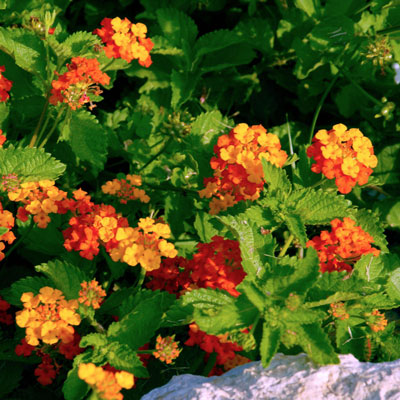
Hardiest of the shrub-form lantanas, this one comes back each spring.
My hiking routes took me past scores of big clumps of lantanas blooming beautifully and bringing in bees and butterflies from miles around.
I figured that any plant that could survive those austere conditions in that part of Texas deserved to be tried in landscapes on more hospitable terms. That was 1958-60, and I know it’s hard to believe that we really didn’t grow many lantanas back then, but the interest in native Texas plants really hadn’t hit yet. Few grew Texas sage. No one had desert willow. We’d never heard of Mexican feather grass or Lindheimer’s muhly, and Salvia greggii was still 20 years from hitting the big time.

McKinney landscape is decorated with bright lantana colors in summer just a couple of years ago.
But if you jump ahead to current times, lantanas are some of our best summertime annuals. And with interest in bees and butterflies at their greatest, this is a good time to talk about lantanas again.
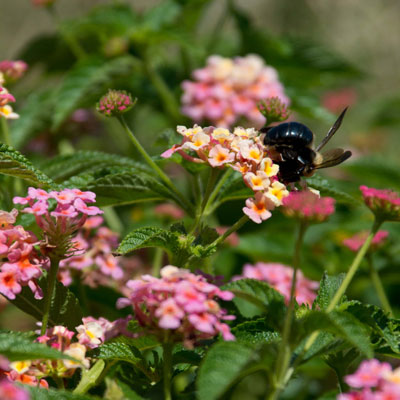
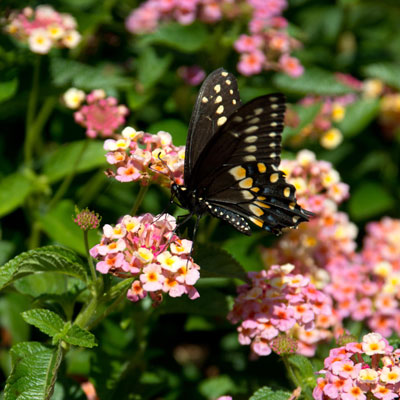
Bumblebee and swallowtail enjoy themselves on planting of Pink Caprice lantanas.
What it takes to grow lantanas well…
• Lighting: Lantanas require full or nearly full sunlight.
• Soils: Good drainage is essential. Lantanas thrive in almost any kind of soil, so long as they’re never waterlogged. They do especially well in pots when they’re planted in a high quality, highly organic potting soil mix.

Lantana flower heads are proudly displayed above durable foliage.
• Fertilizer: Lantanas bloom on new growth, so keep them nourished with nitrogen. If you have them in beds, use the same fertilizer you apply to your turfgrass. If you have them in pots, use a water-soluble, very high-nitrogen plant food, and apply it a couple of times each week.
• Pruning: Little shearing is required, other than to maintain an attractive form. It’s best not to try to give lantanas squared edges and tops – just let them grow naturally.
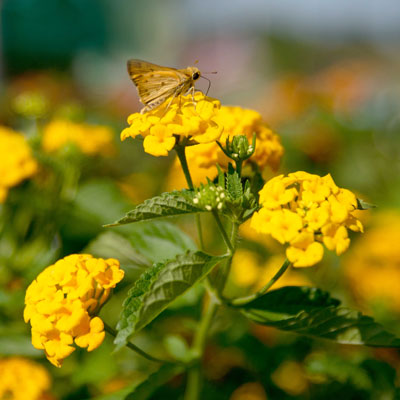
New Gold lantana is one of few triploid (sterile) hybrids that will not set seed.
• Deadheading: Most lantanas will tend to cycle in and out of flower. That’s because they set seeds, and the seeds slow their new growth. So if you want to trim off the old flowering stems before the seeds start to form, that might speed things along. The variety ‘New Gold’ is notable because it’s a triploid (sterile) hybrid that will not produce fruit. It tends to stay in flower much more of the time.
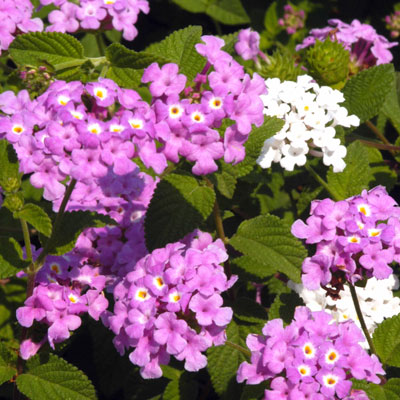
Trailing lavender lantana and its white counterpart are the two shortest types available. They’re also the least winter-hardy.
• Winter protection: Lantanas growing in the ground often return the following spring, especially in the southern half of the state. Yellow and orange types tend to “come back” better than whites and lavenders. Shrubby types tend to come back better than trailers. The morning after the first freeze kills their tops, trim your lantanas off an inch above the ground line, then mulch over them with shredded tree leaves from your landscape. If things work as planned, they’ll re-sprout by early April.
Starting new plants…
Lantanas are started asexually, meaning that they’re either rooted from cuttings or dug and divided. That way each new plant is genetically identical to its mother plant. Cuttings can be taken from soft new growth during the early part of the summer. Plants can be divided as new growth begins in the spring.
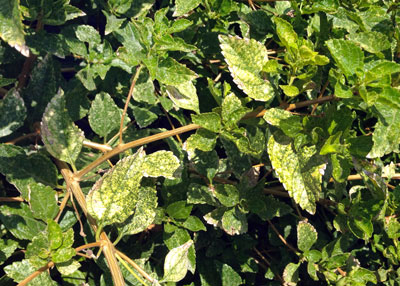
Lace bugs are about the only pest problem to hit lantanas.
Only pest problem…
Occasionally lantanas will be struck down by lace bugs. Look for early signs of the characteristic tan mottling. You’ll also see black, waxy specks on the backs of the leaves. Apply one of the general-purpose contact insecticides as soon as you see this. Try to hit a time when the plants have cycled out of bloom so bees and butterflies won’t be around. Avoid systemic insecticides for that very same reason.
